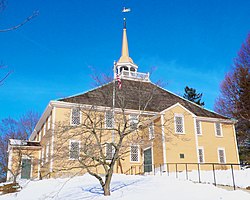Old Ship Church
|
Old Ship Church
(Old Ship Meetinghouse) |
|

Old Ship Church
|
|
| Location | Main Street Hingham, Massachusetts |
|---|---|
| Coordinates | 42°14′29″N 70°53′13″W / 42.24125°N 70.88695°WCoordinates: 42°14′29″N 70°53′13″W / 42.24125°N 70.88695°W |
| Built | 1681 |
| Part of | Lincoln Historic District (#90001728) |
| NRHP Reference # | 66000777 |
| Significant dates | |
| Added to NRHP | October 15, 1966 |
| Designated NHL | October 9, 1960 |
| Designated CP | January 7, 1991 |
The Old Ship Church (also known as the Old Ship Meetinghouse) is a Puritan church built in 1681 in Hingham, Massachusetts. It is the only surviving 17th-century Puritan meetinghouse in America. Its congregation, gathered in 1635 and officially known as First Parish in Hingham, occupies the oldest church building in continuous ecclesiastical use in the United States. On October 9, 1960, it was designated a National Historic Landmark and on November 15, 1966, it was added to the National Register of Historic Places.
Old Ship Church is, according to The New York Times, "the oldest continuously worshiped-in church in North America and the only surviving example in this country of the English Gothic style of the 17th century. The more familiar delicately spired white Colonial churches of New England would not be built for more than half a century." Within the church, "the ceiling, made of great oak beams, looks like the inverted frame of a ship," notes The Washington Post. "Built in 1681, it is the oldest church in continuous use as a house of worship in North America."
The most distinctive feature of the structure is its Hammerbeam roof, a Gothic open timber construction, the most well-known example that of Westminster Hall. Some of those working on the soaring structure were no doubt ship carpenters; others were East Anglians familiar with the method of constructing a hammerbeam roof.
The first minister of the Hingham congregation who built Old Ship was the Rev. Peter Hobart, who had attended what was then Puritan-dominated University of Cambridge. Natives of Hingham in the county of Norfolk in East Anglia, Peter Hobart, his father Edmund and his brother Capt. Joshua Hobart were among Hingham's most prominent early settlers. Edmund Hobart and his wife Margaret (Dewey), said Cotton Mather, "were eminent for piety...and feared God above many." Assisting Hobart in the foundation of the congregation was Rev. Robert Peck, Hobart's senior and formerly rector of St Andrew's Church in Hingham, Norfolk.
...
Wikipedia


